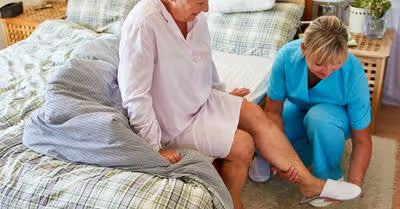Table of Contents
Osteoarthritis
The first type of Arthritis we’ll discuss is Osteoarthritis (from the Greek “osteon,” meaning bone). It’s also called OA for short. Osteoarthritis can be the result of joint injury or obesity. However, it’s most commonly just because of normal wear and tear on your joints. It’s also by far the most common type of Arthritis for people to experience in their lifetime, because it’s caused by experiencing a life. OA affects around 27 million Americans, and the chance of developing it increases with age. Most people over the age of sixty have OA to some extent, but the severity varies from person to person. Ladies, this type of Arthritis is more likely to affect you than your male counterparts after fifty.
The common effects are inflammation, breakdown, and ultimate loss of cartilage in your joints. Places you may notice the effects of Osteoarthritis are the hands, hips, knees, and lower back.
If you’re noticing bony growths around the edges of your joints, then that is a good indicator that you should talk to your doctor about Osteoarthritis. In addition, your joints might feel weaker, warmer, and more tender than before. That generally means that you’re losing muscle bulk or your cartilage is weakening.
There isn’t a known cure for OA, but don’t despair! There are quite a few treatments available to improve your quality of life and make it easier to deal with. Medications, such as Tylenol or any other doctor prescribed medication can help ease joint pain and tenderness. For severe cases, you can visit a physical therapist, and they can help you improve your range of movement and general well-being. The best news is that the most surefire way to combat OA is to maintain a healthy body weight and an exercise routine. The point of your golden years is to do the things you love, and that should help you keep the OA away. Don’t be afraid to go golfing, chase the grandkids, or get out on the dance floor and stay active!
Rheumatoid Arthritis
The second type of Arthritis you need to be aware of is Rheumatoid Arthritis, or RA. RA affects over 1.5 million people in the United States, and the disease is three times more common in women than men.
RA is the only common type of Arthritis that also affect parts of the body other than joints and cartilage. RA is a long-term and progressive auto-immune disease. This one can be a little bit tricky to diagnose at early stages, seeing as it’s also a systematic disease, which means it will affect the whole body and it bears similar symptoms to other ailments. However, it does focus more on joints and organs, with inflammation, swelling, and discomfort.
Some of the more common symptoms are joint deformity, symmetrical joint involvement- which is one of the defining traits of RA. Other symptoms include joint pain, stiffness, and swelling in more than one joint.
However, even though this disease isn’t a basket of rainbows, there are a wide variety of treatments and medications available. The most common medicines would be disease-modifying antirheumatic drugs. These can not only slow down the progression of RA, but also save tissues and joints from permanent damage. Another option for those of you that may not want to take medication can see an Occupational Therapist for advice or treatment. Even good old fashioned rest and relaxation can help. So don’t substitute it for medical attention, but take an awesome nap in a hammock, do a face mask, watch some TV, and do things that make you feel relaxed. You can do a lot to combat RA by merely putting your feet up.
Gout
The third most common form of Arthritis that folks near retirement age encounter would be Gout. Gout affects nearly 8.3 million people, and the risk increases as you get older. Men are more susceptible to an attack, but for women, the risk increases after menopause.
What causes Gout? Gout is caused by high levels of uric acid in the bloodstream. Uric acid is a product of the metabolic breakdown of purine nucleotides, and it should typically be removed in your urine. Your body naturally produces some purines, and they can also be found in some kinds of food and certain drinks. Purines aren’t inherently bad, it’s just that having an overage of them that aren’t being flushed out can cause Gout.
Gout can feel just as relentless as the tax man, and bring you just as much glee. Gout causes swelling, stiffness, and intense pain in a joint. The joint it usually affects is in the big toe, and last anywhere from 3-10 days. The attacks can come quickly and without warning. You may have a long break in between the first few attacks, but it can return more frequently and damage the joints over time. Therefore, even if you haven’t had an attack recently, it’s smart to stay aware of the possibility and continually work to rid yourself of Gout. It can spread to other toe joints, ankles, knees, elbows, wrists, or fingers.
The majority of Gout cases are treated by medication, which can also prevent future attacks. An easy way to avoid Gout is to stay active, avoid drugs, and copious amounts of alcohol (beer, liquor, and even wine have purines). There are dietary choices that you can make to reduce your risk of Gout as well, such as minimizing fat, meat, and yeast. A big plate of bacon-wrapped steak with a beer is the delicious enemy here. It’s also important to drink plenty of fluid, and maintain a healthy body weight.
While there are hundreds of different types of Arthritis, these are the three that most frequently people around retirement age have, or develop in the years that follow. Many of the other types are more likely to appear with other illness or closer to adolescence.
Overall, the best way that you can keep Arthritis at bay, is to stay physically active. There are so many different exercises or things that you can do. We’re going to give you a swift rundown of a bunch to provide you with a place to start. Some joint-friendly exercises are; biking, swimming, water aerobics, walking, hiking, kayaking, yoga, snowshoeing, golf and for the adventurous- rocking climbing and tai chi. Just find an exercise that you love doing because those exercises can improve your quality of life, mood, and joint function. Ultimately, you know your body best. If something doesn’t seem quite right, it’s always best to be cautious and talk to your doctor. If you are diagnosed with Arthritis, then take comfort in knowing treatment options are plentiful, effective, and with or without Arthritis, your retirement years should be spent enjoying yourself, and taking care of yourself. You’ve earned it.
Recent Articles
















